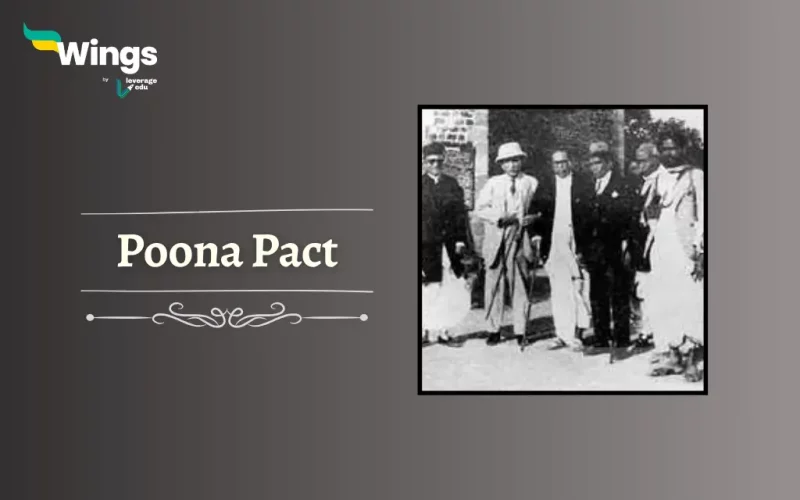The Poona Pact refers to a significant historical agreement signed between Dr. Bhimrao Ramji Ambedkar and Mahatma Gandhi. It emerged somewhere between India’s year-long struggle for independence and an autonomous status. Additionally, this unique Pact not only changed the political sphere of India but also successfully reserved seats in the legislature for marginalized communities. Read this blog to find out the background of the Poona Pact, its key features, and interesting details!
Table of Contents
What is the Background of the Poona Pact?
Ambedkar demanded separate electorates for the depressed classes during the First Round Table Conference held in 1930.
- On the 16th of August 1932, the British Prime Minister, Ramsay MacDonald, declared the famous Communal Award.
- Moreover, it advocated for separate electorates for the depressed classes of the society, including the Muslims, Sikhs, Europeans, Christians, and Anglo-Indians.
- The 1932 Communal Award was primarily based on the notions of the Morley-Minto Reforms and the Government of India Act 1919.
- According to the concept of separate electorates, every community was allocated a specific number of seats in the legislature.
- Moreover, only members from that particular community were eligible to vote and elect a representative to legislative assemblies.
- Additionally, despite the massive popularity in favour of the Communal Award, a few people including Mahatma Gandhi were in the opposition.
- It was believed that such initiatives adhered to the British policies of divide and rule.
- Consequently, they also believed that the demand for a separate electorate would mean that the depressed classes were not a part of the society.
Also Read: Indian History Notes on Lord Willingdon’s Life and Role in India
What is the Poona Pact and Why?
The Poona Pact was an agreement signed between B. R. Ambedkar and M. K. Gandhi in the year 1932.
- The Pact advocated for the political representation of the depressed classes, commonly used for scheduled castes, untouchables, and Dalits.
- Upon the declaration of the Communal Award by Ramsay Macdonald, Gandhi saw it as a danger to the unity of the Hindu community that would ultimately alienate untouchables.
- Thus, Gandhi announced a fast unto death on the 20th of September 1932 while being in prison till the time the concept of separate electorates was removed from the Communal Award.
- Accordingly, it was believed that the best way to terminate Gandhi’s fast was to begin negotiations between Ambedkar and him.
- In the end, the Poona Pact of 1932 was announced between Gandhi and Ambedkar.
- This was followed by Gandhi breaking his fast on the 26th of September 1932.
Also Read: Second Round Table Conference: Participants, Consequences
What are the Main Features of the Poona Pact?
Furthermore, the main features of the Poona Pact are:
- The Poona Pact is a document composed in a quasi-legal style.
- It features a total of 9 points out of which seven talk about the representation of the depressed classes at the central and provincial legislatures.
- Moroever, rather than putting out the feature of separate electorates, the Pact emphasised the system of joint electorates paired with reserved seats.
- According to the Poona Pact, 148 seats were reserved for depressed classes.
- Interestingly, the number of seats reserved relied on the total strength of Provincial Councils.
- For instance, 8 seats were for Punjab, 30 for Madras, 14 for Bombay and Sindh, 18 for Bihar and Orissa, 30 for Bengal, 20 for Central Provinces, 7 for Assam, and 20 for the United Provinces.
- In addition to this, the Pact further called for non-discrimination of depressed classes in public services.
- The Pact also asked to set aside a specific portion of the education grant for depressed classes.
- Furthermore, 19% of the seats were reserved in the Central Legislature.
- Members from these sections who were qualified to vote would ultimately form an electoral college.
- Additionally, this college would then elect a panel of 4 candidates on the grounds of a single vote.
- Therefore, four candidates who got the highest number of votes would be elected.
- Then, the four candidates would stand in the election for the assembly along with the general candidates where the general electorate would vote.
- In this way, the members of the marginalised communities got a double vote as they could vote under the general electorate as well.
FAQs
The purpose of the Poona Pact was to draw an agreement between Mahatma Gandhi and Bhim Rao Ambedkar.
The ultimate result of the Poona Pact was to reserve a specific number of seats for depressed classes of society. This helped them gain relevant political representation like other sections.
The Poona Pact was signed on 24 September 1932 in the Yerwada Central Jail or Pune.
Relevant Blogs
| Nehru Report 1928 | Sarkaria Commission |
| Subsidiary Alliance | Two Nation Theory |
| SNDP Movement | Surat Split |
| Young Bengal Movement | Azad Hind Fauj |
| Wood’s Despatch | Gandhi Irwin Pact |
This was all about the Poona Pact. If you want to read more articles like this! You can get Study notes on the Modern History of India here. Also, you can visit our general knowledge page on Indian History!
 One app for all your study abroad needs
One app for all your study abroad needs













